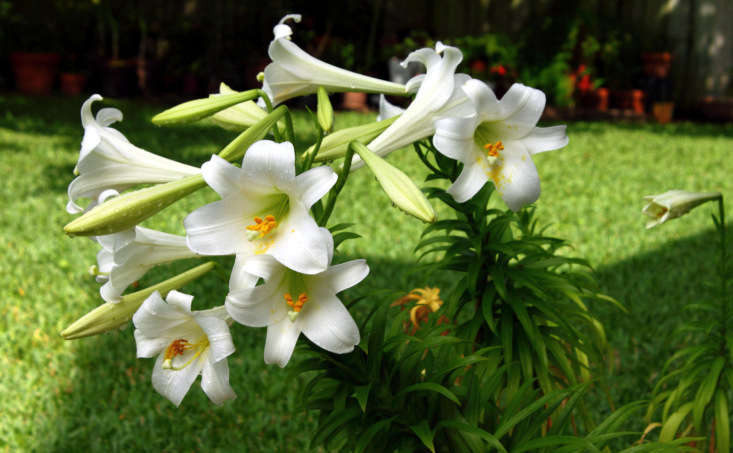“Lilies as a group are very difficult,” wrote the late, great gardening writer Henry Mitchell. “What is especially difficult and infuriating about lilies is that they will grow like virtual weeds and bring on a great flush of triumph and, alas, hubris. Then they totally disappear or steadily decline, despite much activity and bustle with the leaf mold, aphid sprays, and urgent prayers.”
Consider yourself warned.
But note that lily’s fickle nature did not prevent Mitchell from loving lilies—or from cosseting them in his own garden in Washington, D.C. “Have them flower a year or two, and when they dwindle away (as they certainly will with anything less than first-rate drainage) you can pretend you got inferior bulbs.”
And oh, what a summer show lilies will put on in the garden during their short, sweet lifespans. From delicate, dangling earring flowers of martagon lilies (as shown above) to the heady perfume of Oriental lilies (not to mention the showy colorful flowers of Asiatic lilies), why not plant a few varieties and hope for success?
With nearly 100 species of Lilium, how to choose? Read on for growing and plant care tips:
Martagon Lily

With stalks that can reach heights of five feet and be heavy with dozens of dangling flowers, martagon lilies faded in popularity during the Victorian era when adventurous explorers discovered dramatic Asian lilies with enormous flowers and brought them home to Europe. The delicacy of the flowers on martagon lilies make them excellent companions in a flower bed, where they won’t try to overwhelm their neighbors with showiness.
See more ideas for using martagon lilies on a shady slope in 10 Ideas to Steal from the Romantic Gardens at Kiftsgate Court.
How to Plant Lilies:
- Well-drained soil is a must. Add compost or amendments to clay to make it fluffier.
- Plant lilies in groups or three or five, or seven bulbs for greater impact.
- Neutralize acidic soil by digging in some lime before you plant lily bulbs.
- Ignore the advice to plant lilies in autumn. Order them to plant in March (or whenever the soil thaws in your growing zone) to avoid having the bulbs sit in wet ground over the winter.
Oriental Lily

Oriental lilies can reach stately heights (up to 6 feet) and can be excellent anchors in the back of a flowr border in July and August. Colors can range from pure white to splotched (with red or pink) to shades of reds and pinks. Their petals curve outward, inviting you to bend down to catch the scent of their perfume. For an unusual gray Oriental lily (‘Silver Scheherazade’) and other gray flowers, see 10 Easy Pieces: Gray Flowers.
Star Gazer Lily

Star Gazer Oriental Lily Bulbs currently are on sale for $8.99 for a bag of three (a 50 percent discount) at American Meadows.
Asiatic Lily

Asiatic lilies are scentless, which differentiates them from fragrant Oriental lilies. They can grow to heights of 6 feet and have large, showy flowers that bloom in vivid colors including orange, yellow, peach, and red.
Easter Lily

The American philanthropist Bunny Mellon grew beds full of Asiatic lilies in the gardens of her sprawling, 2,000-acre Virginia estate, Oak Spring Farms. See more of the planting scheme in Garden Visit: Bunny Mellon at Oak Spring Farms.
Formosa Lily

Formosa lilies are especially valuable as late bloomers which you can count on to flower from August to October when other perennials are flagging in the heat. Their large, trumpet-shaped flowers can be as large as 10 inches.
Trumpet Lily

Hardy in USDA growing zones 4 to 9, trumpet lilies like full sun and well-draining soil.
For a tall, orange trumpet lily that will thrive in the summer garden, Lilium Henryi is $19.95 for three bulbs from White Flower Farm.
Regal Lily

Daylilies

Despite a similar appearance to their flowers, daylilies are not lilies. They belong to Hemerocallis genus (not Lilium). But that didn’t stop Vita Sackville-West from planting daylilies at Sissinghurst and it shouldn’t stop you.
For more growing tips, see Lily: A Field Guide in our Garden Design 101 guides to Perennials and Bulbs & Tubers. Read more:
- Landscape Ideas: 9 Flowers to Add Color to a Garden
- 10 Things to Do in the Garden in June
- Salvias: Late-Season Saviors in the Garden
- Not a lily: Calla Lily: A Field Guide to Planting, Care & Design








Have a Question or Comment About This Post?
Join the conversation